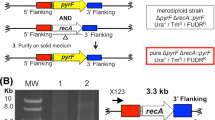Abstract
Transformation of the thermophileClostridium thermosaccharolyticum ATCC 31960 was achieved using plasmid pCTC1 and electroporation. Evidence supporting transformation was provided by Southern blots, detection of the plasmid in 10 out of 10 erythromycin-resistant clones, retransformation ofE. coli andC. thermosaccharolyticum with plasmid DNA isolated fromC. thermosaccharolyticum, and a proportional relationship between the number of transformants and the amount of DNA added. Transformation efficiencies were very low for plasmid DNA prepared fromE. coli (0.6 transformants mg−1 DNA), although somewhat higher for plasmid DNA prepared fromC. thermosaccharolyticum (52 transformants mg−1 DNA). Transformation-dependent erythromycin resistance indicates that an adenosine methylase gene originating fromEnterococcus faecalis, a mesophile, is expressed inC. thermosaccharolyticum. The plasmid pCTC1 appears to be replicated independently of the chromosome, as indicated by visualization of recovered plasmid on gels, and retransformation using recovered plasmid. pCTC1 is maintained inC. thermosaccharolyticum at both 45 and 60°C. Restriction analysis showed little or no rearrangement occurred upon passage through the thermophile.
Similar content being viewed by others
References
Allen SP and HP Blaschek. 1988. Electroporation-induced transformation of intact cells ofClostridium perfringens. Appl Environ Microbiol 54: 2322–2324.
Allen SP and HP Blaschek. 1990. Factors involved in the electroporation-induced transformation ofClostridium perfringens. FEMS Microbiol Lett 70: 217–220.
Birrer GA, WR Chesbro and RM Zsigray. 1994. Electro-transformation ofClostridium beijerinckii NRRL B-592 with shuttle plasmid pHR106 and recombinant derivatives. Appl Microbiol Biotechnol 41: 32–38.
Brehm J, G Salmond and N Minton. 1987. Sequence of the adenine methylase gene of theStreptococcus faecalis plasmid pAMβ1. Nucleic Acids Res 15: 3177.
Bruand C, SD Ehrlich and L Jannière. 1991. Unidirectional theta replication of the structurally stableEnterococcus faecalis plasmid pAMβ1. EMBO J 10: 2171–2177.
Charbonnier F and P Forterre. 1994. Comparison of plasmid DNA topology among mesophilic and thermophilic eubacteria and archaebacteria. J Bacteriol 176: 1251–1259.
Drlica K. 1992. Control of bacterial DNA supercoiling. Mol Microbiol 6: 425–433.
George HA and J-S Chen. 1983. Acidic conditions are not obligatory for onset of butanol formation byClostridium beijerinckii (synonym,C. butylicum). Appl Environ Microbiol 46: 321–327.
Gruss A and SD Ehrlich. 1989. The family of highly interrelated single-stranded deoxyribonucleic acid plasmids. Microbiol Rev 53: 231–241.
Guerinot ML, BA Morisseau and T Klapatch 1990. Electroporation ofBradyrhizobium japonicum. Mol Gen Gen 221: 287–290.
Hogsett DA, H-J Ahn, TD Bernardez, CR South and LR Lynd. 1992. Direct microbial conversion: prospects, progress, and obstacles. Appl Biochem Biotechnol 34/35: 527–541.
Jannière L, C Bruand and SD Ehrlich. 1990. Structurally stableBacillus subtilis cloning vectors. Gene 87: 53–61.
Lee Y, MK Jain, CY Lee, SE Lowe and JG Zeikus. 1993. Taxonomic distinction of saccharolytic thermophilic anaerobes. Int J Syst Bacteriol 43: 41–51.
Lynd LR. 1989. Ethanol production from lignocellulosic substrates using thermophilic bacteria. Adv Biochem Eng/Biotechnol 38: 1–52.
Lynd LR, H-J Ahn, G Anderson, P Hill, DS Kersey and TA Klapatch. 1991. Thermophilic ethanol production: investigation of ethanol yield and tolerance in continuous culture. Appl Biochem Biotechnol 28/29: 549–570.
Maniatis T, EF Fritsch and J Sambrook. 1982. Molecular Cloning: A Laboratory Manual. Cold Spring Harbor Press, Cold Spring Harbor.
Mermelstein LD, NE Welker, GN Bennett and ET Papoutsakis. 1992. Expression of cloned homologous fermentative genes inClostridium acetobutylicum ATCC 824. Bio/Technology 10: 190–195.
O'Sullivan DJ and TR Klaenhammer. 1993. Rapid mini-prep isolation of high-quality plasmid DNA fromLactococcus andLactobacillus spp. Appl Environ Microbiol 59: 2730–2733.
Perun TJ. 1971. The chemistry and conformation of erythromycin. In: Drug Action and Drug Resistance in Bacteria (S Mitsuhashi, ed), pp 123–152, University of Tokyo Press, Tokyo.
Peteranderl R, EB Shotts Jr and J Weigel. 1990. Stability of antibiotics under growth conditions for thermophilic anaerobes. Appl Environ Microbiol 56: 1981–1983.
Phillips-Jones MK. 1990. Plasmid transformation ofClostridium perfringens by electroporation methods. FEMS Microbiol Lett 66: 221–226.
Saddler JN and MK-H Chan. 1984. Conversion of pretreated lignocellulosic substrates to ethanol byClostridium thermocellum in mon-and co-culture withClostridium thermosaccharolyticum andClostridium thermohydrosulphuricum. Can J Microbiol 30: 212–220.
Scott PT and JI Rood. 1989. Electroporation-mediated transformation of lysostaphin-treatedClostridium perfringens. Gene 82: 327–333.
Slapack GE, I Russell and GG Stewa. 1987. Thermophilic microbes in ethanol production. CRC Press, Boca Raton.
Soutschek-Bauer E, L Hartl and WL Staudenbauer. 1985. Transformation ofClostridium thermohydrosulfuricum DSM 568 with plasmid DNA. Biotechnol Lett 7: 705–710.
Venkateswaran S and AL Demain. 1986. TheClostridium thermocellum-Clostridium thermosaccharolyticum ethanol production process: nutritional studies and scale-down. Chem Eng Commun 45: 53–60.
Wang J-Y and M Syvanen. 1992. DNA twist as a transcriptional sensor for environmental changes. Mol Microbiol 6: 1861–1866.
Williams DR, DI Young and M Young. 1990. Conjugative plasmid transfer fromEscherichia coli toClostridium acetobutylicum. J Gen Microbiol 136: 819–826.
Zhou Y and EA Johnson. 1993. Genetic transformation ofClostridium botulinum Hall A by electroporation. Biotechnol Lett 15: 121–126.
Author information
Authors and Affiliations
Rights and permissions
About this article
Cite this article
Klapatch, T.R., Guerinot, M.L. & Lynd, L.R. Electrotransformation ofClostridium thermosaccharolyticum . Journal of Industrial Microbiology 16, 342–347 (1996). https://doi.org/10.1007/BF01570112
Received:
Accepted:
Issue Date:
DOI: https://doi.org/10.1007/BF01570112




